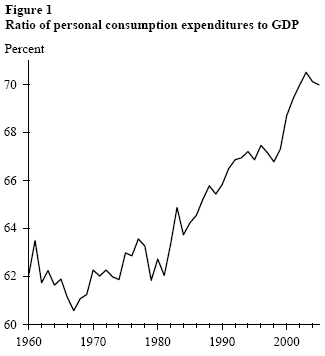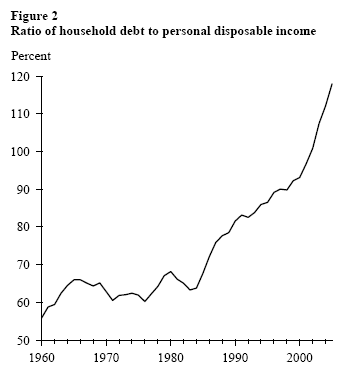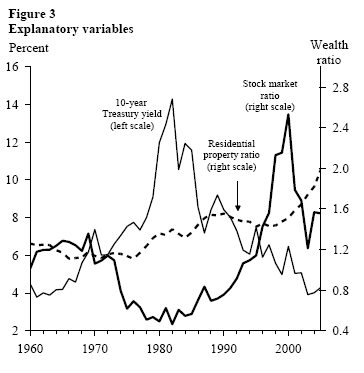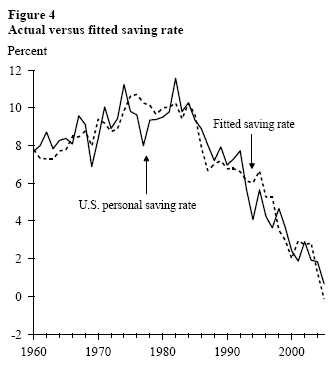In September 2005, the personal saving rate out of disposable income was negative for the fourth consecutive month. A negative saving rate means that U.S. consumers are spending more than 100% of their monthly after-tax income.
In September 2005, the personal saving rate out of disposable income was negative for the fourth consecutive month. A negative saving rate means that U.S. consumers are spending more than 100% of their monthly after-tax income. The recent data are part of a trend of declining personal saving rates observed for two decades. During the 1980s, the personal saving rate averaged 9.0%. During the 1990s, the personal saving rate averaged 5.2%. Since 2000, the personal saving rate has averaged only 1.9%.
This Economic Letter discusses some of the factors that appear to be driving the secular decline in the personal saving rate. These factors include rapid increases in stock market and residential property wealth, which households apparently view as a substitute for the quaint practice of putting aside money each month from their paychecks. Rapidly rising stock and house prices, fueled by an accommodative environment of low interest rates and a proliferation of “exotic” mortgage products (loans with little or no down payment, minimal documentation of income, and payments for interest-only or less) have sustained a boom in household spending and provided collateral for record-setting levels of household debt relative to income.
Going forward, the possibility of cooling asset markets and rising borrowing costs may cause the personal saving rate to revert to levels which are more in line with historical averages. While such a development would act as near-term drag on household spending and GDP growth, an increase in domestic saving would help correct the large imbalance that now exists in the U.S. current account (the combined balances of the international trade account, net foreign income, and unilateral transfers).
 The aggregate personal saving rate computed by the U.S. Bureau of Economic Analysis (BEA) is the fraction of after-tax personal income that remains after subtracting various types of consumption expenditures. Some commentators argue that the BEA understates the actual saving rate because the definition of saving omits capital gains on stock portfolios and real estate which, other things equal, raise the net worth of households. Others maintain that capital gains should not be included in the definition because they represent the return from past saving activity which has already been counted; assets showing capital gains today were presumably acquired in the past using the residual of disposable income minus consumption. Many also note that capital gains on previously acquired assets can be fleeting if they are the result of speculative price appreciation, i.e., bubbles. Finally, even when justified by fundamentals, price appreciation on previously acquired assets does not create any new productive assets. The latter are a crucial source of long-run productivity gains and improved living standards.
The aggregate personal saving rate computed by the U.S. Bureau of Economic Analysis (BEA) is the fraction of after-tax personal income that remains after subtracting various types of consumption expenditures. Some commentators argue that the BEA understates the actual saving rate because the definition of saving omits capital gains on stock portfolios and real estate which, other things equal, raise the net worth of households. Others maintain that capital gains should not be included in the definition because they represent the return from past saving activity which has already been counted; assets showing capital gains today were presumably acquired in the past using the residual of disposable income minus consumption. Many also note that capital gains on previously acquired assets can be fleeting if they are the result of speculative price appreciation, i.e., bubbles. Finally, even when justified by fundamentals, price appreciation on previously acquired assets does not create any new productive assets. The latter are a crucial source of long-run productivity gains and improved living standards.
Other issues surrounding the measurement of the saving rate include the method of accounting for employer pension contributions (which are treated as income even though these funds are not available for immediate use by households) and education expenditures by households (which are treated as consumption even though the spending may augment the stock of human capital).
 While measurement issues can influence the computed level of the saving rate on a given date, the basic claim that household saving activity has been declining over time remains valid. Other evidence supports the idea that U.S. households are becoming less saving-oriented and more consumption-oriented. The ratio of nominal U.S. personal consumption expenditures to nominal GDP has been trending up since the early 1980s and is now hovering near an all-time high of 70% (Figure 1). The U.S. consumption binge has been accompanied by a parabolic rise in household debt; the ratio of total household debt to personal disposable income now stands at an all-time high of 118% (Figure 2).
While measurement issues can influence the computed level of the saving rate on a given date, the basic claim that household saving activity has been declining over time remains valid. Other evidence supports the idea that U.S. households are becoming less saving-oriented and more consumption-oriented. The ratio of nominal U.S. personal consumption expenditures to nominal GDP has been trending up since the early 1980s and is now hovering near an all-time high of 70% (Figure 1). The U.S. consumption binge has been accompanied by a parabolic rise in household debt; the ratio of total household debt to personal disposable income now stands at an all-time high of 118% (Figure 2).
Much of the recent run-up in household debt has been mortgage-related; low interest rates have spurred a refinancing boom that has allowed consumers to extract equity from their homes to pay for a variety of goods and services. According to data compiled by Greenspan and Kennedy (2005), borrowing against home equity generated an average of $425 billion per year in spendable cash from 2001 through 2004—more than twice the average of $177 billion per year over the preceding four-year period.
Explaining the declining saving rate


A large body of research has examined the causes and consequences of the declining personal saving rate (for an overview, see Marquis 2002). Building on this research, a simple statistical model of household saving behavior can be constructed by regressing the personal saving rate on a constant and three explanatory variables: (1) the ratio of household stock market wealth to personal disposable income, (2) the ratio of household residential property wealth to personal disposable income, and (3) the yield on a 10-year Treasury bond. The explanatory variables are plotted in Figure 3. The wealth ratios capture the idea that households perceive asset appreciation to be a substitute for the practice of saving out of wage income. The 10-year Treasury yield is a measure of the perceived return to saving and captures the fact that asset valuation ratios are strongly influenced by movements in nominal interest rates (see Lansing 2004).
Figure 4 plots the U.S. personal saving rate together with the fitted saving rate from the model. The simple behavioral model can account for 89% of the variance in the U.S. personal saving rate from 1960:Q1 to 2005:Q1. A slightly improved fit can be obtained by adding a time trend to the regression equation. A time trend is a proxy for ongoing credit industry innovations (growth of subprime lending, home equity loans, exotic mortgages, etc.) which have expanded consumer access to borrowed money and reduced the need for precautionary saving.
Figure 4 suggests that the decades-long decline in the U.S. personal saving rate is largely a behavioral response to long-lived bull markets in stocks and housing together with falling nominal interest rates over the same period. Since 2000, the rate of residential property appreciation has been more than double the growth rate of personal disposable income. In many areas of the country, the ratio of house prices to rents (a valuation measure analogous to the price-earnings ratio for stocks) is at an all-time high, raising concerns about a housing bubble. Reminiscent of the widespread margin purchases by unsophisticated investors during the stock market mania of the late-1990s, today’s housing market is characterized by an influx of new buyers, record transaction volume, and a growing number of property acquisitions financed almost entirely with borrowed money.
According to the model, the personal saving rate would be expected to halt its decline and start moving up if stock or housing markets sagged, or if long-term interest rates jumped, say, due to inflation fears. An increase in the personal saving rate would slow the growth of household spending which, in turn, would have negative implications for the derived demands of business investment, inventory accumulation, and business hiring. But, on a positive note, a pickup in saving activity in the household sector would help offset the ongoing deficit spending in the government sector. A rise in net domestic saving would reduce the U.S. economy’s reliance on foreign capital inflows as a source of saving. At present, the U.S. current account deficit stands at more than 6% of GDP, implying that the U.S. economy must draw in around $3 billion per day from foreign investors to finance domestic spending.
The decline in domestic saving activity and the accompanying increase in the U.S. current account deficit have been labeled “unsustainable” by many analysts and commentators. To help bring about a smooth, orderly adjustment of the imbalance, former Federal Reserve Chairman Paul Volcker (2005) has called for the United States to undertake a combination of policy measures to “forcibly increase its rate of internal saving, thereby reducing its import demand.”
Policy options to increase internal saving include: (1) a decision by lawmakers to restore fiscal discipline in the government sector, (2) tax reforms that encourage saving by shifting the tax base towards consumption, and (3) the use of monetary policy to lean against asset price bubbles, since these stimulate consumption at the expense of saving. The first two options face hurdles of political feasibility, while the third remains somewhat controversial; it is an unsettled question whether central banks should take steps to prevent or deflate asset price bubbles (see Lansing 2003 and Rudebusch 2005). There is widespread agreement, however, that forward-looking central banks should address the expected impacts of asset price movements on spending, inflation, and the allocation of resources. Federal Reserve Chairman Alan Greenspan (2005) recently acknowledged that: “Our forecasts and hence policy changes are becoming increasingly driven by asset price changes.”
The decline in the U.S. personal saving rate and the dearth of internal saving raise concerns for the future. In coming decades, a growing fraction of U.S. workers will pass their peak earning years and approach retirement. In preparation, aging workers should be building their nest eggs and paying down debt. Instead, many of today’s workers are saving almost nothing and taking on large amounts of adjustable-rate debt with payments programmed to rise with the level of interest rates. Failure to boost saving in the years ahead may lead to some painful adjustments in the future when many of today’s workers could face difficulties maintaining their desired lifestyle in retirement.
Kevin J. Lansing
Senior Economist
Greenspan, A. 2005. “Reflections on Central Banking.” Remarks at a symposium sponsored by FRB Kansas City, Jackson Hole, Wyoming, August 26.
Greenspan, A., and J. Kennedy. 2005. “Estimates of Home Mortgage Originations, Repayments, and Debt on One-to-Four-Family Residences.” Federal Reserve Board, Finance and Economics Discussion Series Paper 2005-41.
Lansing, K.J. 2003. “Should the Fed React to the Stock Market?” FRBSF Economic Letter 2003-34 (November 14).
Lansing, K.J. 2004. “Inflation-Induced Valuation Errors in the Stock Market.” FRBSF Economic Letter 2004-30 (October 29).
Marquis, M. 2002. “What’s Behind the Low U.S. Personal Saving Rate?” FRBSF Economic Letter 2002-09 (March 29).
Rudebusch, G.D. 2005. “Monetary Policy and Asset Price Bubbles.” FRBSF Economic Letter 2005-18 (August 5).
Volcker, P.A. 2005. “An Economy on Thin Ice.” Washington Post, April 10, page B07.
Opinions expressed in FRBSF Economic Letter do not necessarily reflect the views of the management of the Federal Reserve Bank of San Francisco or of the Board of Governors of the Federal Reserve System. This publication is edited by Anita Todd and Karen Barnes. Permission to reprint portions of articles or whole articles must be obtained in writing. Please send editorial comments and requests for reprint permission to research.library@sf.frb.org